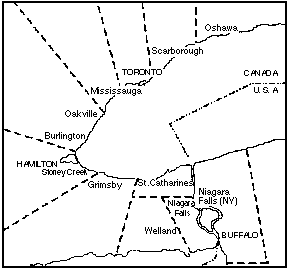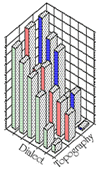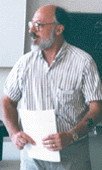
Excerpts from J.K. Chambers, "Social embedding of changes in progress." Journal of English Linguistics 26 (1998)
Though some [features of Canadian English] have been recognized in casual observations as changing for some time, we now have the wherewithal to view them systematically by examining their use by a large sample of men and women ranging in age from 14 to over 80 in a large urban region in southern Ontario. The Dialect Topography of the Golden Horseshoe (Chambers 1994) surveys the western tip of Lake Ontario from Oshawa to Niagara Falls, including the conurbations of Scarborough, Toronto, Mississauga, Oakville, Burlington, Hamilton, St. Catharines and Welland (shown in Figure 1). This 250 km strip is the most populous region of Canada, the home of more than one-sixth of Canada's population.

Dialect Topography is designed to provide a macro-level perspective on regional linguistic variation. The survey method purposely exploits contemporary conditions to provide rapid data-gathering from a large representative population (as discussed in detail in Chambers 1993b, 1994). In the Golden Horseshoe, postal questionnaires were distributed to demographically suitable respondents by local contacts, usually teachers at various educational levels and activity directors in retirement homes. Some of the questions have been used in previous surveys, thus providing a test for the reliability of the questions as well as comparable data-elicitation. Responses are computerized with routines for mapping, crunching (by VarbRul) and presentation.
The survey sample is a cross-section of 1,015 people, made up of 935 Canadians and 80 Americans across the border in the Niagara Falls-Buffalo region. Through most of Canadian history, the Golden Horseshoe region has exerted considerable cultural influence as well as (or perhaps because of) industrial, economic and political clout....
1.4. Yod-Dropping
The merger of /u/ and /ju/ after coronals is nearing completion in many parts of the English-speaking world, including middle-class England, the northern U.S., and Canada.
The generality of this linguistic change would normally deprive it of special interest in a discussion of changes taking place specifically in CE but this change may be more significant in Canada than in some other places. At least two commentators claim that yod-retention--the pronunciation of /ju/ after coronals--is a prestige feature in CE. According Pringle (1985: 190):
So are most Canadians, judging by their responses to these two questions in the Golden Horseshoe survey:

The trajectory of change in Figure 5 is very mild. The percentage of yod-dropping is relatively high for the oldest respondents and it inches higher for the younger ones. For people under 40, the pronunciations of both student and news occur without yod for more than 80 per cent of the respondents. For people over 40, the word student retains its yod somewhat longer than news. Although yod-dropping is still increasing in the speech of younger people, pronunciations with yod are minority pronunciations even for 70-year-olds, that is, even for people born in the 1920s.
If Canadians were in the habit of 'putting on airs' by pronouncing students as st[ju]dents and news as n[ju]s, they would surely do so when answering the language-survey questionnaire for the Dialect Topography project. They do not. Yod-dropping is not only common and standard but also unmonitored.
Landsberg, Michele 1980 "'Toozday' scrapes my nerves raw." Toronto Star. Thursday, June 26. Section C.
Pringle, Ian 1985 "Attitudes to Canadian English." In Sidney Greenbaum, ed., The English Language Today: Public Attitudes to English. Oxford: Pergamon Press. 183-205.
 |
 |